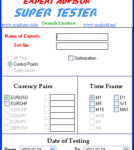
EA SUPER TESTER Multi-threaded testing program for Expert Advisor

Forex Market – Original Source

Description
In the Futures Market, traders engage in standardized contracts to buy or sell an underlying asset at a predetermined price at a future date.

Understanding the Futures Market and Futures Contracts: A Simple Example
Imagine you and I live in the agricultural state of Iowa.
I raise cows, and you grow corn.
Our farms are 15 miles apart.
Every autumn, you bring me your entire corn crop, which I buy to feed my steers.
We agree that I’ll pay you the market price at the Chicago Board of Trade (CBOT) on the day I receive your corn.
The Importance of Corn Prices
Corn is vital for both of us.
It’s your primary crop and my steers’ main food source.
I expect low prices, you expect high prices. This may be due to events such as large export orders and Ukraine.
The Proposal of a Forward Contract
One spring day, you propose we set the price for next fall’s corn crop in advance.
You suggest choosing a mutually beneficial price now to avoid worrying about price fluctuations in September, allowing us to plan our economic activities better.
We agree on $3.00 per bushel, forming a Forward Contract—an agreement between buyer and seller to trade at a future date.
Drawbacks of Forward Contracts
While beneficial, Forward Contracts have drawbacks.
If prices soar to $3.50 due to a large order, you might want to break our contract.
Similarly, if prices drop to $2.50, I might not want to honor our agreement.
Other issues like crop failure, ownership changes, or bankruptcy can also affect compliance.
The Definition of a Futures Contract
To address these problems, Futures Contracts were developed.
A Futures Contract is a standardized Forward Contract.
For instance, a CBOT corn Futures Contract specifies 5,000 bushels of grade #2 yellow corn with delivery months in March, May, July, September, and December.
This standardization ensures that Futures Contracts are Fungible, allowing only the price to be negotiated by the parties.
Flexibility and Standardization
Unlike Forward Contracts, Futures Contracts can be canceled through an Offset Transaction in the Futures Market.
They are traded exclusively through Exchanges, ensuring a regulated and standardized process.
Money Movement in Futures Markets
Another difference is the handling of money.
In a Forward Contract, payment is deferred until the transaction occurs.
In Futures Trading, you must place a Margin—a deposit indicating your intention to fulfill the contract.
If prices rise, the value of your Futures Contract increases, resulting in Unrealized Profits.
These can be converted into cash without closing the Futures Position.
Exiting a Futures Contract
One crucial feature of a Futures Contract is the ease of exiting.
In a Forward Contract, both parties must agree to cancel the contract.
In Futures Trading, you can close your position by selling the Futures Contract, providing greater flexibility.
Conclusion
Futures contracts offer a standardized, regulated, and flexible alternative to forward contracts, addressing many of the latter’s drawbacks.
By understanding these differences, traders can better navigate the complexities of the financial markets and make more informed decisions.
However, there is more depth to explore when it comes to the Futures Market, especially regarding its relationship with the Forex market, the use of MetaTrader platforms, and the strategies traders employ to manage risk.
Let’s delve deeper into the interplay between Futures and Forex, how traders utilize Expert Advisors (EA) on MetaTrader platforms, and the importance of robust risk management tools.
As we expand our understanding, we will also highlight some advanced approaches, technology integrations, and modern analytical methods that can enhance your trading performance.
By the end, you will have a more comprehensive view of how the Futures Market can complement your overall trading strategy and how to seamlessly integrate it with various trading tools and software solutions.
The goal is to ensure you not only grasp the fundamental concepts but also feel confident exploring and utilizing Futures Contracts as part of a diversified portfolio.
From the mechanics of execution to the psychology of market participants, this extended exploration will provide insights for both novice and experienced traders.
Let’s continue by examining how Futures relate to the global Forex market and what this implies for traders who operate in multiple asset classes.
Futures and Forex
The Forex market is the largest financial market in the world, where currency pairs are traded over-the-counter (OTC) without a centralized exchange.
On the other hand, the Futures Market centralizes transactions on established exchanges, ensuring standardization and transparency.
While Forex markets deal directly with currency pairs, Futures Contracts can cover a wide range of underlying assets, including currencies, commodities, stock indices, and even cryptocurrencies.
For traders who are used to the Forex environment, dealing with Futures means adapting to a more standardized set of contract specifications and understanding the concept of margining that aligns with exchange regulations.
In Forex, leverage is provided by brokers, and the cost structures can vary significantly, while in Futures, margin requirements are set by the exchange and clearinghouse.
This standardized margining system in Futures often results in a more transparent and stable trading environment, but it also means traders must be aware of initial and maintenance margin requirements, as well as daily mark-to-market adjustments.
Combining the liquidity and vastness of Forex with the robustness and clarity of the Futures Market can diversify a trader’s approach.
A trader might hedge Forex positions using currency Futures or employ arbitrage strategies that take advantage of price discrepancies between the OTC Forex market and regulated Futures Exchanges.
Understanding the correlation and the differences between these markets can help traders find unique opportunities and spread risk across different instruments.
When integrating both markets, it is crucial to consider contract sizes, tick values, and settlement times to ensure that positions across Futures and Forex are effectively managed.
This combination requires a solid foundational knowledge of both market structures, as well as the use of sophisticated trading tools and strategies.
Now, let’s look at how trading platforms like MetaTrader can facilitate access to both Forex and certain Futures instruments, and how to leverage Expert Advisors (EAs) to automate and optimize your trades.
MetaTrader and Futures
The MetaTrader platform, available in versions like MT4 and MT5, is widely recognized in the Forex trading community for its intuitive interface, advanced charting tools, and support for Expert Advisors (EAs).
While MetaTrader was primarily designed for Forex trading, many brokers and third-party providers now offer access to Futures instruments on the same platform.
This integration allows traders to manage both Forex and Futures positions within a single environment, simplifying the workflow and reducing the need to switch between multiple platforms.
By using MetaTrader, traders gain access to an extensive library of technical indicators, charting tools, and the ability to develop and implement Expert Advisors (EAs) in MQL4 or MQL5 programming languages.
An EA can be programmed to recognize specific market conditions in Futures, initiate trades based on defined criteria, and even manage risk parameters like StopLoss (Stop Loss) and TakeProfit (Take Profit).
For example, traders can deploy a highly specialized Expert Advisor (EA) that monitors Futures Contracts of crude oil, corn, or currency pairs listed on the CME, and automatically places trades when certain technical patterns emerge.
The ability to backtest and optimize these EAs using the built-in Strategy Tester in MetaTrader provides a critical edge.
For instance, a trader looking to refine their approach to trading currency futures could use the Tester Pad tool, a Forex trading simulator for strategy testing, to simulate various market conditions and test the performance of their automated strategies.
Similarly, if a trader wants to replicate or mirror their trades across multiple terminals or accounts, tools like Copylot can help synchronize trade executions in different MetaTrader instances, ensuring consistent strategy application across multiple platforms.
For those who seek a more advanced level of customization, something like the EA The xCustomEA can serve as a universal trading advisor capable of integrating custom indicators and strategies tailored to Futures instruments as well as Forex.
By leveraging these tools and the flexibility of MetaTrader, traders gain the freedom to experiment, refine, and deploy sophisticated strategies in the Futures Market with a familiar and user-friendly interface.
Next, we will dive into specific techniques and strategies that traders use in the Futures Market, and how these can complement their Forex activities.
Strategies and Techniques in the Futures Market
There are a wide range of trading strategies that can be employed in the Futures Market, each with its own risk profile and skill requirements.
Some traders focus on Scalping, a technique where they attempt to profit from small price movements throughout the trading session.
Others may engage in Hedging, using Futures Contracts to offset potential losses in their Forex or stock portfolio.
Speculation is also common, where traders anticipate future price movements based on fundamental and technical analyses.
Some might utilize Arbitrage strategies, seeking risk-free profits by exploiting price discrepancies between related Futures Contracts or between Futures and Forex markets.
In addition, Spread Trading—taking offsetting positions in two different but related Futures Contracts—can help reduce risk by focusing on the price difference rather than the absolute price level.
Pairs Trading, a form of relative value strategy, is another popular method, especially when dealing with correlated commodities or currency futures.
For longer-term traders, Position Trading involves holding Futures Contracts for days, weeks, or even months, aligning trades with macroeconomic trends and fundamental insights.
In all these strategies, proper risk management tools—such as well-placed StopLoss and TakeProfit orders—are crucial.
Trailing Stop techniques are also employed to lock in profits as the market moves in a favorable direction.
Tools like the Assistant can support positions and deals with real/virtual StopLoss / TakeProfit / Trailing Stop, helping traders efficiently manage their trades.
Furthermore, for those who want to improve their trade management efficiency, VirtualTradePad (VTP) Trading Panel allows one-click trading from the chart and keyboard, streamlining the execution process.
This combination of strategies and tools underscores the versatility of the Futures Market as a complementary arena for Forex traders.
The next step is to understand how to use these strategies alongside advanced risk management techniques, data analysis, and Expert Advisors to create a well-rounded trading plan.
Risk Management and Analysis in the Futures Market
Effective risk management is paramount in the Futures Market.
Given the leverage involved, a relatively small price movement can lead to significant gains or losses.
Traders must understand Margin requirements and be prepared for daily mark-to-market settlements where profits and losses are realized as the contract value changes.
This process ensures that losses are not allowed to accumulate unchecked, which helps maintain the financial integrity of the exchange.
At the same time, traders must set appropriate StopLoss levels and consider TakeProfit targets to balance the risk/reward ratio.
Tools like the CLP CloseIfProfitorLoss utility help automate control of total profit or loss, with the added benefit of profit trailing features, ensuring traders do not miss opportunities to protect their capital.
When employing advanced analytical methods, traders often rely on both Technical Analysis and Fundamental Analysis.
Technical Analysis involves studying charts, identifying patterns, and using indicators to predict future price movements.
For example, traders might rely on a universal Expert Advisor (EA), such as The X, which uses standard indicators to generate trading signals applicable to both Forex and Futures markets.
Fundamental Analysis looks at economic indicators, supply and demand factors, geopolitical events, and macroeconomic trends that can influence the underlying asset.
For commodities futures, this might include weather reports affecting crop yields or inventory data for oil reserves.
By combining these analyses, traders aim to form a holistic view of the market, enabling more informed decision-making.
Automation tools and EAs can also incorporate both technical and fundamental filters, scanning the market for optimal entry and exit points, and even integrating with external data sources.
While analysis is crucial, documentation and performance tracking should not be overlooked.
Traders can use tools like the Extra Report Pad – Trader’s Diary for professional analysis of their trading account, similar to what MyFxBook does, but directly in the live chart environment.
This allows traders to refine their strategies, identify strengths and weaknesses, and continuously improve their approach.
Next, we will consider the technical aspects of integrating Futures trading into the MetaTrader environment, including how to properly install and manage Expert Advisors and indicators.
Technical Integration: Installing EAs and Indicators for Futures in MetaTrader
To fully leverage the capabilities of MetaTrader for Futures trading, traders must know how to properly install and configure Expert Advisors and custom indicators.
Installing EAs and indicators in MetaTrader is straightforward, but must be done correctly to avoid errors.
Resources like How to install Expert Advisor and indicators to the MetaTrader terminals provide step-by-step instructions to ensure a seamless setup.
Traders must also pay attention to the version of MetaTrader they are using (MT4 or MT5), as well as the compatibility of the EA or indicator with that platform.
Once installed, traders can access the Expert Advisors and indicators from the Navigator panel and apply them to their Futures charts.
It’s important to test and optimize EAs using tools like the built-in Strategy Tester or third-party utilities to ensure the best possible performance.
For instance, a trader might test their EA’s ability to manage a Trailing Stop in volatile market conditions or assess how it handles different Margin requirements imposed by the Futures Exchange.
If issues arise, traders can consult error codes and troubleshooting resources, such as Error Codes from Metatrader and MQL and Forex. Solutions., to quickly resolve problems and maintain a stable trading environment.
With proper technical integration, traders can enjoy a smooth and reliable trading experience, focusing more on strategy development and execution rather than platform maintenance.
As we move forward, let’s consider how the right infrastructure and platform configuration can further enhance your Futures trading experience.
Infrastructure and Platform Configuration for Futures Trading
Having the right technological setup can make all the difference in Futures trading.
A stable internet connection, reliable VPS (Virtual Private Server), and a well-configured MetaTrader environment ensure that orders are executed swiftly and without interruption.
Traders often use a Forex VPS designed for MetaTrader 4/5, as highlighted by Forex VPS MetaTrader 4/5, to run their EAs around the clock, ensuring minimal downtime and latency.
Low latency is especially important in Scalping or high-frequency strategies, where even a slight delay can affect the outcome of a trade.
By optimizing data feeds, reducing slippage, and ensuring quick order execution, traders can improve the overall profitability and consistency of their Futures trading strategies.
Additionally, utilizing built-in features like alerts, push notifications, and Telegram integration can keep traders informed about market conditions and trade executions in real-time.
For instance, integrating MetaTrader with Telegram channels and bots allows traders to receive instant updates or even execute commands remotely, adding another layer of control and convenience.
With the proper infrastructure in place, traders can focus on their strategies and analysis, relying on technology to handle routine tasks and maintain market access.
This leads us to consider how ongoing education, market research, and continuous learning can further improve a trader’s performance in the Futures Market.
Continuous Learning and Market Research
The financial markets are dynamic, influenced by a wide range of factors that evolve over time.
To remain competitive in the Futures Market, traders must stay informed about economic events, technological advancements, and changing market conditions.
Continuous learning involves reading market analyses, following reputable financial news sources, and studying the impact of economic indicators on various Futures Contracts.
Moreover, attending webinars, courses, or engaging in trading communities can provide new insights and strategies.
Experimenting with new EAs or testing strategies in simulated environments like the Testing and optimization of EA in Strategy Tester environment helps traders refine their approach without risking real capital.
By cultivating a habit of research and adaptation, traders can keep their methodologies current and responsive to an ever-changing marketplace.
This proactive approach ensures that traders do not become complacent, instead remaining agile and prepared for whatever challenges and opportunities arise.
Next, we will consider the broader ecosystem that surrounds the Futures Market, including regulatory bodies, brokers, and the importance of reliable market data.
The Broader Ecosystem of the Futures Market
The Futures Market is supported by a robust ecosystem that includes exchanges, clearinghouses, brokers, data providers, and regulatory authorities.
Exchanges like the CME, CBOT, and NYMEX provide the standardized contracts and the clearing function that ensures trades are fulfilled, reducing counterparty risk.
Brokers act as intermediaries, granting traders access to these exchanges while providing trading platforms, customer support, and additional services.
Data providers supply real-time quotes, historical data, and analytical tools, enabling traders to make informed decisions.
Regulatory bodies ensure that the Futures Market operates fairly and transparently, protecting the interests of market participants.
In recent years, technological advancements have expanded the range of tools and services available to traders, from sophisticated charting solutions to AI-driven EAs like AI Sniper that can make more intelligent and informed trading decisions.
Understanding this ecosystem helps traders appreciate the complexity and reliability of the environment in which they operate.
By recognizing the roles of different participants, traders can better navigate the infrastructure, select the right partners, and make use of the available tools to optimize their performance.
This comprehensive understanding sets the stage for a more strategic and well-rounded approach to Futures trading.
Let’s wrap up by highlighting key takeaways and reminding ourselves why the Futures Market is a valuable component of a trader’s arsenal.
Key Takeaways
We began with a basic illustration of how Futures Contracts emerged from the need to manage price uncertainty in agricultural markets.
We then explored how Futures differ from Forward Contracts in terms of standardization, liquidity, and ease of exit.
We examined the interplay between the Futures Market and the Forex market, noting that traders can use both to diversify their portfolios and hedge risk.
The integration of MetaTrader, with its robust charting tools and automated EAs, allows traders to access the Futures Market efficiently.
We highlighted various strategies, from Scalping to Hedging, and underscored the importance of effective risk management techniques like StopLoss, TakeProfit, and Trailing Stop.
We considered how infrastructure, data quality, and continuous learning are critical components of long-term success.
Ultimately, by understanding the mechanics of the Futures Market, leveraging modern technology, and applying sound trading strategies, traders can enhance their results and navigate financial markets with greater confidence.
The Futures Market is not merely a place for speculation but a sophisticated environment where informed participants manage risks, discover prices, and strive for profitability.
With the right tools, knowledge, and approach, this dynamic market can serve as a valuable addition to any trader’s toolkit.
As you continue to refine your trading journey, remember that success in Futures—as in any financial market—requires discipline, flexibility, and a commitment to ongoing improvement.
“The Futures Contract is not just a financial instrument; it’s a bridge between uncertainty and opportunity, guiding traders to more informed and strategic decisions.”
Interesting posts
- “30 Rules of a Successful Forex Trader”
- Forex Glossary – Basic Concepts and Definitions
- Forex trading for beginners Part 1: Financial Markets
- Forex trading for beginners Part 2: Currency, Hedge
- Forex trading for beginners Part 3: Activities, Quotes
- Forex trading for beginners Part 4: Fundamental analysis, Rates
- Forex trading for beginners Part 5: Exchange rate, Manufacturing indicators
- Forex trading for beginners Part 6: Consumer demand indicators
- Forex trading for beginners Part 7: Market psychology, Types of charts, Trend Analysis
- Forex trading for beginners Part 8: Trendlines
- Forex trading for beginners Part 9: GRAPHIC PRICE MODELS
- Forex trading for beginners Part 10: MATHEMATICAL ANALYSIS, Indicators
- Forex trading for beginners Part 11: Trade Patterns
- Links to banks, stocks, exchanges…
- We are searched for by such words
- Market History
- Support and Resistance Levels
- Auto Trading and Trading robots
- CFD – Contract for Difference
- What is hedging
- Forex Market – Origins
Esta publicación también está disponible en: English Portuguese Español Deutsch Українська Chinese Русский Français Italiano Türkçe 日本語 한국어 العربية Indonesian ไทย Tiếng Việt






